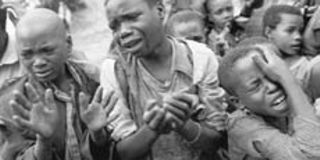10 lessons from the Rwanda genocide

Children cry and p[lead for mercy as the genocide rages in Rwabnda in 1994.
As the world remembers the 1994 genocide in Rwanda, PAUL UDOTO takes a look at what should have been done, as outlined by Human Rights Watch
The week of mourning over the Rwandan genocide starts today as the world remembers the events of 1994 which marked the country's darkest 100 days.
At least 800,000 Tutsis and Hutu moderates were shot, hacked and clubbed to death by Hutu extremists, while a quarter of Rwandan children were left orphans.
Hutu militias used mass rape as a weapon, and today it is estimated that two-thirds of Tutsi women are HIV-positive and up to 13 per cent of Rwanda's 8.5 million people are living with Aids. Nearly one-third of all households are headed by women because many men were killed.
The Human Rights Watch, a US-based international NGO monitoring the violation of people's rights all over the world last month outlined the 10 lessons to be drawn from the genocide:-
Lesson One: Stop the genocide before it becomes one.
The genocide in Rwanda began suddenly after the killing of the President, but the attitudes and practices that made it possible developed over years of discrimination against the Tutsi, the people who would be targeted during the genocide.
Lesson Two: React promptly and firmly to preparations for the mass slaughter of civilians.
Many Rwandans, diplomats and United Nations officials knew that the militia were being recruited and trained to kill. But even when an informant told UN peacekeepers that the they were meant to attack Tutsi civilians, there was no effective intervention.
Lesson Three: Pay close attention to the media in situations of potential ethnic, religious or racial conflict.
In cases of impending genocide, be prepared to silence broadcasts that incite or provide directions for violence. For three years before the genocide, newspapers like Kangura had identified Tutsi as "enemies of the nation" to be scorned and feared. A private radio station supported by many influential government, military and political figures, broadcast the same message with increasing virulence and effect in the nine months before the genocide was launched.
A year before the genocide, leading Rwandans and international observers all deplored the media campaign against Tutsis and the opposition parties. But no one intervened to actually stop the calls to hatred or to promote the broadcast of countervailing messages of tolerance. The US considered jamming the broadcasts from an airplane, but found the cost–about $8,000 (about Sh600,000) an hour–too high.
Lesson Four: Be alert to the impact of negative models in nearby regions.
In late 1993 and early 1994, tens of thousands of Hutus and Tutsis were slain in neighbouring Burundi, a country demographically similar to Rwanda. These killings, skilfully exploited by Rwandan propagandists, significantly increased tensions in Rwanda. Both the slaughter and the absence of international reaction to it encouraged the planners of genocide to proceed with the attempt to eliminate the Tutsi.
Lesson Five: Obtain accurate information about what is happening on the ground.
n In 1994, the governments most involved in Rwanda – France, Belgium, and the US – had substantial information about the situation on the ground, but they shared this information with only a few others. Non-permanent members of the Security Council–with the exception of Rwanda, itself then a non-permanent member,–depended for information on the UN secretariat.
Lesson Six: Identify and support opponents of the genocide.
At the beginning, many Rwandans opposed the genocide. When potential leaders of resistance, including military officers, appealed for foreign support in the first days of the killings, they were refused. Instead of supporting these resisters, the Security Council undermined them by reducing the already inadequate number of peacekeepers.
Lesson Seven: Call the genocide by its rightful name and vigorously condemn it.
Commit to permanently opposing any government involved in genocide, including by refusing it assistance in the future. Rwandan government officials, military officers and political leaders who directed the genocide claimed to be legitimate authorities giving appropriate orders for the self-defence of the population.
This pretext of legitimacy made it easier for them to persuade people to violate usual moral and legal prohibitions.
Lesson Eight: Impose an arms embargo on the genocidal government.
Many killers used machetes or home-made weapons, but soldiers, the police and thousands of militia used firearms in launching attacks on churches, schools, hospitals and other sites where thousands of Tutsis had gathered.
A first wave of relatively few assailants killed thousands of civilians by using small arms, grenades, and mortars. They left the survivors of such attacks terrorised and vulnerable to assault by a second wave of killers wielding machetes and home-made weapons.
Lesson Nine: Press any government seeming to support the genocidal government to change its policy.
Some governments, particularly France and several in Africa, continued to support the Rwandan government throughout the genocide. This limited the impact of condemnation by those other governments that did finally take a stand against the slaughter.
Lesson Ten: Be prepared to intervene with armed force.
The organisers of the genocide were relatively few, but they controlled three elite military units. Backed by these forces, they were able to assert control first over other units of the army and national police and then over the administrative system.




